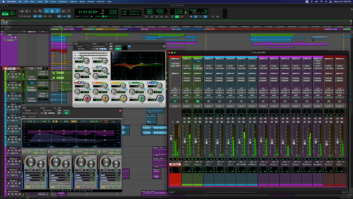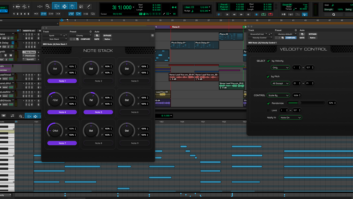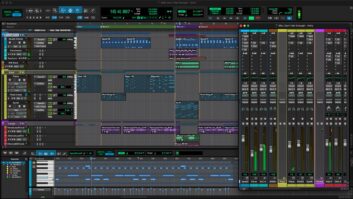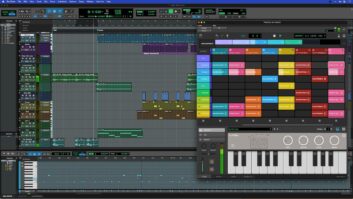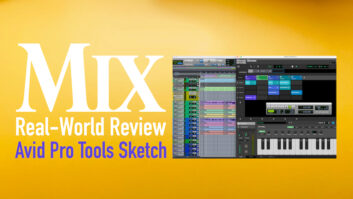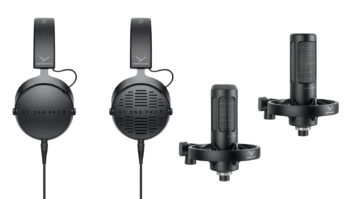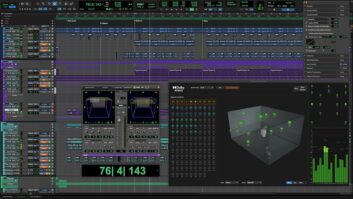There are a lot of great TDM plug-ins available, but most of these are designed as day-to-day work tools (compressors, EQ, gates, tube emulators, etc.) and aren’t suited for serious sound mangling. During those times when we need to morph, mutate and warp a track into something entirely new and different, only a truly twisted plug-in will do-you know, the kind where what goes in sounds nothing like what comes out. Although we’re seeing more and more plug-ins of this ilk, really good manglers of the TDM variety are still rare. Up steps Bruno/Reso, by Digidesign, an innovative real-time plug-in dedicated to mutilating your waveforms.
Bruno/Reso is actually two separate plug-ins, Bruno and Reso, bundled together because of their similarities. The plug-ins have look-alike user interfaces and employ the same sound generation algorithm, dubbed cross-synthesis. This technique takes an audio track as its basic tone source and runs it through a variety of synthesizer- type effects (e.g., amplitude ADSR, filtering, glide, detune, etc.). The resulting sound can then be played via a MIDI keyboard, or other controller, just as you would any other polyphonic synth.
FINDING YOUR TONEAs usual, Bruno/Reso comes on a CD-RoM and is copy-protected via key disk. Running the installer program from the CD-RoM puts both plug-ins, Bruno and Reso, into your DAE folder’s Plug-Ins folder. Upon booting your application, straight mono and mono-to-stereo versions of each plug-in will appear among your insert choices.
Bruno and Reso can be inserted on any audio or aux channel, just like other plug-ins. However, unlike most plug-ins, you won’t hear a sound right away. A signal isn’t passed through Bruno or Reso until a note is received. As mentioned earlier, the note can come from a MIDI controller, assuming, of course, you have a DAE-compatible MIDI digital audio sequencer (e.g., Digidesign’s Pro Tools 5.0 or Emagic’s Logic Audio 4.0). If you’re working in an audio-only application, not to worry, the plug-ins sport a handy onscreen keyboard. It’s fine for clicking on single notes, and a Latch feature allows you to hold a chord, but forget about doing any fancy licks.
Each plug-in requires an entire DSP chip, specifically, an SRAM chip. With three SRAM chips per MIX card, this allows up to three instances at once. The plug-ins are optimized for MIX cards to provide a full 24 voices of polyphony. DSP Farm cards only provide eight voices of polyphony.
There aren’t a whole lot of presets to get you started: Bruno has 11 and Reso only has six. None of them are particularly impressive, but then, what the presets sound like is dependent on your source audio track. For a quick first impression, check out the demo that comes on the installation disc. It does a decent job of demonstrating the plug-ins, although it really only scratches the surface of what is possible. Ultimately, it’s up to you to get down and dirty, tweaking parameters to really get the most out of this software.
FACE TO FACEThe difference between Bruno and Reso lies in the way they treat the audio source track. Bruno employs a time-slicing effect, grabbing chunks of the source track and crossfading them together. This creates a sound that is full of movement as timbres are continually smeared and blended over time, much like the old PPG or Korg Wavestation. Reso synthesizes new harmonic overtones directly from the source audio. The results range from underwater bubble tones to harsh metallic bleeps and wah-wah effects on speed.
The front panels of both plug-ins are clearly laid out into four sections: Timbre, Pitch, Amplitude and Voice. The Amplitude and Pitch parameters for Bruno and Reso are identical. In the Amplitude section, there’s an ADSR envelope that you can shape by clicking and dragging breakpoint handles or through direct numerical entry. There are also controls for overall gain, wet-to-dry effect ratio and stereo spread. The envelope is used each time a note is struck and is velocity sensitive. The Pitch area contains portamento, bend amount, detune, and master tune parameters. The detune amount can be controlled by velocity-a cool performance trick-call it the detuned crescendo effect.
The plug-ins can function in either mono or polyphonic modes and feature voice stacking in numbers of two, four, eight or 24 (that, obviously, is mono by default). These parameters are found in the Voice section. Reso also sports LPF controls in this area. There are knobs for adjusting frequency, Q and envelope follow.
Reso’s Timbre controls include resonance and high-frequency damping for taming the resonator’s edge. Both parameters are velocity sensitive. Harmonics can be dialed in as all, odd only or toggled between these two settings. The Timbre section on Bruno contains a crossfade dial for adjusting the rate at which slices are culled from the source track and faded together. A Switch LED flashes green when slices are butt-spliced rather than crossfaded. More switching and less crossfading makes for a choppier, more rhythmic, effect. The amount of switching is determined by the dynamics of the source track or an outside source.
One of my favorite things about Bruno and Reso is that they respond to key input and MIDI beat clock. Bruno’s time-slicing effects-the switching I just mentioned-can be controlled by these sources. These signals can also control the timing of Reso’s all- and odd-harmonics switching. A threshold knob lets you adjust when the switching will take place, and another dial lets you choose MIDI note values. Note selections are 11/44, 11/48 or 11/416 and include dotted and triplet values. I was disappointed that 11/432 notes aren’t included, as this is a popular division for drum ‘n’ bass-type riffs. Nevertheless, having all these triggering options available opens up a whole world of ambient groove effects.
RESONATING HARMONIESThe types of effects that you can cook up with Bruno/Reso are definitely useful, especially if you’re into electronica or trance music production. If this is your bag, I highly recommend checking it out. Hardcore sound designers may also find it interesting, particularly for dark, droning background noises. If more traditional music production and recording is your gig, this plug-in probably isn’t for you-but you never know, you might find it inspiring. At $395, the package is a fraction of the price of a comparable hardware unit. I have a feeling we’ll be hearing this plug-in more and more, whether we know it or not, in contemporary arrangements. I know I’ll be using it.
